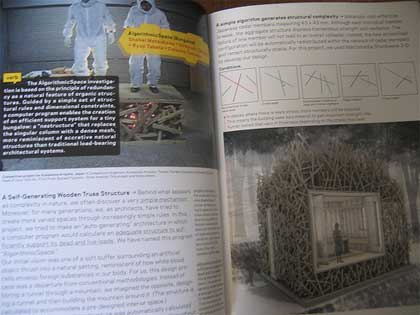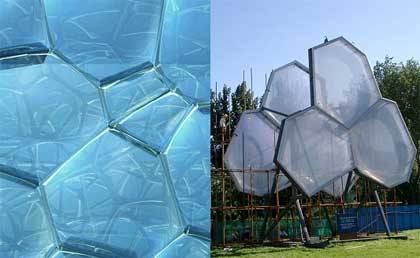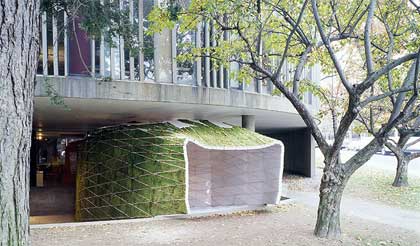), edited by: Albert Ferré, Irene Hwang, Tomoko Sakamoto, Ramon Prat, Michael Kubo, Mario Ballesteros and Anna Tetas.
Editor’s blurb: “What is fascinating is the inability to separate the real from the digital, because they already form part of the same nature.â€? So we said in the last issue of Verb. Here we explore how this fusion takes place. Buildings and cities grow, are transformed, and dissolve. How can this evolution be generated, controlled, enhanced or imagined? Is our environment programmable? How does the fusion of natural and artificial matter produce new architectural organisms, new environments, new natures? How does technology animate space, and how do users and programs animate matter? The fifth volume of Actar’s boogazine looks for a new definition of the organic.
A “boogazine”? It’s a hybrid volume designed to combine the flexibility of a magazine with the depth and format of a book. Published since 2002 by Barcelona-based editor Actar, each of the boogazines explores a specific aspect of current architectural production.
I wish they had kept the book habit to write a few lines about the editors.
 The AlgorithmicSpace
The AlgorithmicSpace
Don’t be fooled by the term “natures”. Here, the “natural” often looks supernatural and its realization is most of the time informed by algorithms, strict geometry rules and other mathematical processes. The book is thus quite techy but even i could understand what the techniques are about. I found that it was actually the strong point of the book: the many images, graphics, interviews with the designers, researchers or architects and clear explanations of the vocabulary and building strategies made me feel very smart. I managed to get a deeper understanding of construction and design processes which i would otherwise find too arcane and sophisticated.
 Beijing’s Watercube (more images)
Beijing’s Watercube (more images)
The book focusses on over 20 projects, some are ueber-famous, others were new to me. I was particularly happy to get more insight on the Beijing National Aquatics Centre (nicknamed “the watercube”) or R&Sie fabulous Dusty Relief in Bangkok. The book goes beyond buildings and looks at interactive rooms (Ada in Zurich), ports (Fugee Port in Taiwan), the artificial reconstruction of a natural mountain (the Dénia project on the Spanish coast) but also design projects such as Clemens Weisshaar & Reed Kram‘s Breeding Tables which were launched 2 years ago (and with much press coverage and public wonder) at the Salone del Mobile in Milan. Oh, yeah! and there’s even some arty projects like the Brooklyn Pigeon Project.
A few years ago, architects Benjamin Aranda and Chris Lasch decided to record New York from the perspective of the movements of a flock of birds. They equipped pigeons with wireless video cameras and microphones, turning them into satellites that fed images and sounds of the city below. As the architects explained in an interview for the book “In conventional satellite and aerial mappings of the earth, an enormous amount of effort is dedicated to squeezing out any trace of movement from the image and even from the environment.” (…) “So by reintroducing time into the map ours is in some ways a more accurate depiction of the world. But funny enough, this doesn’t make it any better map.”
They equipped pigeons with wireless video cameras and microphones, turning them into satellites that fed images and sounds of the city below. As the architects explained in an interview for the book “In conventional satellite and aerial mappings of the earth, an enormous amount of effort is dedicated to squeezing out any trace of movement from the image and even from the environment.” (…) “So by reintroducing time into the map ours is in some ways a more accurate depiction of the world. But funny enough, this doesn’t make it any better map.”
More in this video intro and interview.

